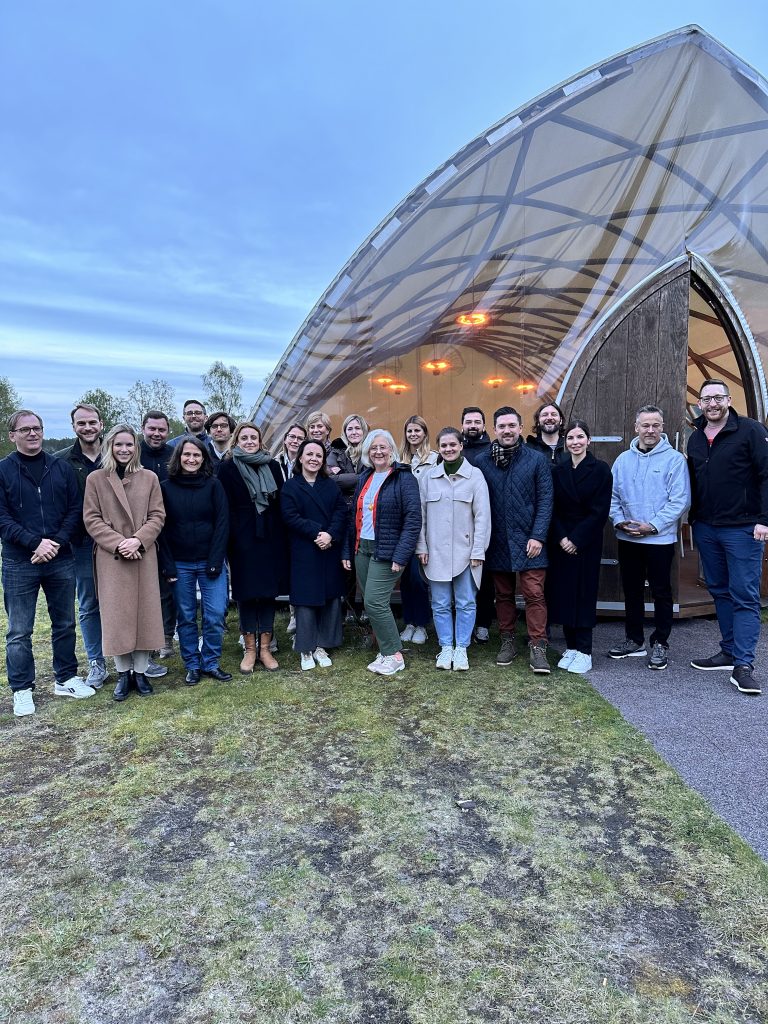After Liz Mohn expressed the wish to create a training program for young leaders from the worlds of business, culture and politics to prepare them for the everyday challenges they will face, we developed a new curriculum based on our many years of experience working with people in positions of leadership. Together with instructor Martin Groß, we launched the Future Leadership Trainings, a program that has now successfully completed its second round. For those who were unable to attend, we’ve put together a list of our Top 12 experiences and insights:
1. Genuine encounters are what count.
Managers doing an eye-gazing exercise? Not too long ago that would have been considered inappropriately intimate. More recently it’s become clear that people in leadership positions are more open to such activities and that they understand: This is how you strengthen connections, empathy, trust and “being seen.”
These are the new leadership questions: How do I “really” look at others? What kind of person am I engaging with here? How are they feeling right now? When we show ourselves authentically, without a mask, we implicitly allow others to do the same. The resulting connection makes it easier to resolve differences, feel safer and be more productive together.
2. No tools!
By design, there are no tools in the Future Leadership Trainings. Instead, there are principles, such as exploring metacognition (expanded perspectives), defining realities (my reality is not yours) and allowing intensity (see eye-gazing).
3. No more whining!
By virtue of their role and function, leaders have a lot of creative power. But they must also use it. You can’t build and shape things if the messages communicated are always negative (“It’s everyone else’s fault, C-level management is inept, it’s just one ongoing crisis and a big fail”) or if leaders do nothing but complain and see themselves as victims. What works is “radical personal responsibility” – something others in the team can also be empowered to practice.
4. Breathwork – how can it help people lead?
We don’t perceive the world as it is, but through the lens of our nervous system. Conscious breathing is a quick way to actively regulate the nervous system and become introspective. Being able to regulate the breath well can be advantageous – including for a leader’s behavior. Breathwork helps people to reduce stress, react more appropriately to social situations, and become more resilient, more adept at interacting with others, more emotionally agile and more willing to take responsibility.
5. Fluid, not reactive.
Running frantically to fight one fire after another – that’s what many managers experience day in and day out. Introspection and self-regulation can free them from the trap of merely reacting unconsciously by helping them look inwards, make a connection with themselves and sense into what’s alive right now. Listening to oneself answers questions such as: How am I currently feeling? What’s important at this very moment? When we’re in the flow and accepting what is, we can resolve inner tensions and take care of the things that really matter. Having a strong inner compass is important, especially in volatile times.
6. Ditch the demotivators.
Motivation is intrinsic. Yet people and teams become demotivated if they feel their work is pointless. As a result, it’s important to recognize and reduce demotivating factors within the organization, to find answers to the question: “What is demotivating my people?”
Demotivators include deadlock, lack of transparency, lack of appreciation, senseless tasks, insufficient resources, power struggles, conflicts, too little feedback, negative communication, reactive, short-term, erratic decisions, and blindly doing anything just to do something.
7. Change the rules!
See above! It’s often the case that the rules determine behavior. When people play Ludo and other competitive board games, the person who wins is the one who is devious, antisocial, unscrupulous and unwilling to show solidarity. When it comes to the leadership game, it’s also true that if you change the rules, you’re very likely to change how people behave.
Behavior often depends more on context than character.
8. Safety instead of tracking
The tendency in management circles is to track everything and everyone to death. Above all, data. At the same time, it’s important to create safe spaces for people who want to try something new: tracking-free zones. Experimenting produces shared experiences that can be evaluated by everyone together – along the lines of “Let’s keep it” or “It didn’t really work.”
9. Golden rule for meetings
“Never attend a meeting if you have nothing to contribute.”
10. Every problem is an emotional problem. Otherwise it wouldn’t be a problem.
That means: Always take emotions very seriously! Try to sense what message, which concern is behind them. Recognize that shame, fear, guilt or sadness is often what fuels anger. “Your body, your emotions are always on YOUR side! Emotions contain messages for you. Try to integrate them more into your leadership efforts.”
11. Communication is more than just broadcasting
… says Daniel Auwermann, ex-naval officer, now an organizational consultant. Alluding to the navy’s process for sending radio messages, he recommends the following for leadership communications: 1. Think, 2. Press the button, 3. Talk, 4. Release the button. With an emphasis on 1. Think and 4. Release the button.
12. Heterogeneity is cool
The Future Leadership Trainings thrive on collaboration in small heterogeneous groups. This provides a protected environment for very different people with similar problems and learning interests to think and work together. The focus is on outcomes that enrich leaders’ everyday lives.
The trainings make it possible for the Liz Mohn Foundation to stay up to date on the issues managers are currently dealing with. The events have revealed how stressful it can be and what the challenges are when managers must lead people from different age groups. The Liz Mohn Foundation incorporates these insights into its own project work in order to move the field of leadership forward.
The three days spent at the venue on Lüneburg Heath were a complete success and generated impressive feedback. We are looking forward to continuing with Module II, which will take place in autumn at Banco Santander in Frankfurt, the workplace of one of the participants.

